Forward editor Caitlin Mackesy Davies learns how a collaborative project at Swansea University is developing solar-energy solutions to make our future buildings far more sustainable.
Forward: features are independent pieces written for Mewburn Ellis discussing and celebrating the best of innovation and exploration from the scientific and entrepreneurial worlds.
While he’s reluctant to tie his career path today too directly to his childhood experiences, Professor David Worsley, Vice President (Innovation) at Swansea University, will perhaps admit that it isn’t entirely usual for family outings to include visits to old slate quarries and ‘coal mines that were in the last throes’ – or to count a trip to the construction site of a huge new pumped-storage hydroelectric facility as ‘a particularly interesting day’.
And as we open a conversation about his current work, Worsley – holder of 12 patents, recent winner of a St David Award for his contributions to Innovation, Science and Technology and the IOM3 Sir Henry Bessemer Gold Medal Winner 2020 for his sustained, long-term interaction with the steel industry – is still able to describe to me quite vividly the day he and his Pa ventured inside one of the 16km of tunnels being carved out of Elidir Fawr to create Dinorwig Power Station (now known as Electric Mountain). It was, he says, ‘one of those ones that sort of sticks in your mind forever’.
It may, he recalls, have been the cool Land Rover in which they went exploring or the great pub lunch that actually made the event so memorable, but there’s no denying the fact that power and how it’s generated has played an enormous part in his pursuits since.
Early question
As a child on those family forays, he says he began to wonder: ‘Why do we need to keep digging things out of the ground and burning them?’ And many years later, he says, the situation still hasn’t changed. ‘We’re still looking downwards for our energy supply, and people have a mindset that they’d like to continue burning things like they always have.’ However, as Research Director of SPECIFIC, an EPSRC Innovation and Knowledge Centre based in the College of Engineering at Swansea University, he’s working with colleagues to remedy that situation – by looking up.
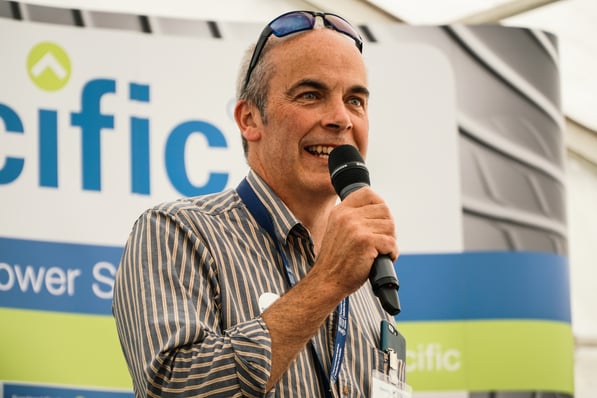
David Worsley
The centre – which is funded by the European Regional Development Fund through the Welsh Government, Innovate UK and the Engineering and Physical Sciences Research Council – ‘develops and integrates solar technologies to reduce carbon emissions, creating buildings that can generate, store and release their own heat and electricity from solar energy’.
It’s one of seven such centres set up to ‘close the gap between scientific research and its commercial exploitation’. Another of its goals is to ‘avoid the mistakes of the past’ by ensuring that future solar tech fits within the circular economy, removing a reliance on extracted materials and hazardous chemicals.
Worsley is clearly excited about solar, which he tells me has already ‘reached maturity with some existing technology’.
For one thing, he says: ‘If we get it right, we can create economic opportunities in countries which at the moment have nothing except sunshine as a resource. If we can store solar-generated energy cheaply, it could move around in the future just as we move oil and gas around now.’ But what’s really exciting, he says, is the new technology that’s coming out of his colleagues and projects.
Power to the people
‘One of the really fascinating things,’ he explains, ‘is that there are now emerging solar technologies that you can apply to metal, glass and plastic substrates using equipment that is very like a T-shirt press.
‘So there's a real buzz in the community of scientists and engineers, because if you imagine that someone who makes T-shirts could also make solar cells, that really does bring a huge democracy to power. If people can make their own solar cells, they can also make their own solar-powered buildings.’
“There are now emerging solar technologies that you can apply to metal, glass and plastic substrates using equipment that is very like a T-shirt press.”
The concept, based on this principle, of a ‘community of energy’ is similar to a trial that Worsley has been involved with in India. There, he says: ‘We are building classroom buildings that have excess power capability, which then means they can supply the neighbouring village properties with power’. So, a classroom building acts ‘like a sort of big power pack for a community’ as well as providing education.
‘This gets over a huge issue in many parts of the world, where people don’t have access to grid electricity or where bringing grid power to them would be really expensive and make that power really expensive too. If you can enable local communities to generate electricity, you bring the control of the power into those communities.’
A taste of the future
However, he tells me, speaking from an unusually sunny South Wales in July, he’s most fired up about what SPECIFIC is doing closer to home, where it has pioneered the concept of the Active Building – ‘a building that supports the wider grid network by intelligently integrating renewable energy technologies for heat, power and transport.’ Active Buildings are designed from the ground up to be energy efficient and have the potential to be energy self-sufficient and to trade energy when connected.
‘We've been able to build energy-positive buildings out of materials that are available now – in a place where it's generally not like it is today, but a bit grey and miserable. And they run all year round off their own infrastructure. That tells me that the dream of a solar-powered future isn't that far away.’
In fact, thanks to the learning taken from SPECIFIC’s first demonstrator buildings – an Active Classroom (completed in 2016) and an Active Office (completed in 2018) – the project is about to give us a taste of the solar future today. The Active Classroom and Active Office integrate energy generation and storage technologies for heat, power and transport, drawing on innovation and expertise from across the engineering disciplines.
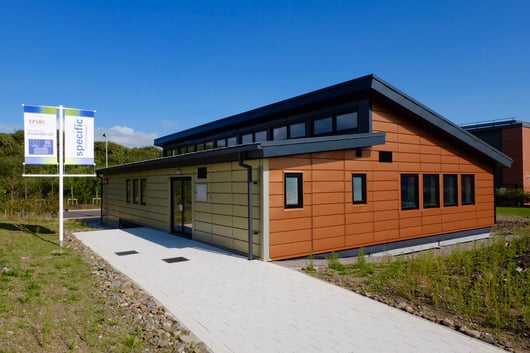
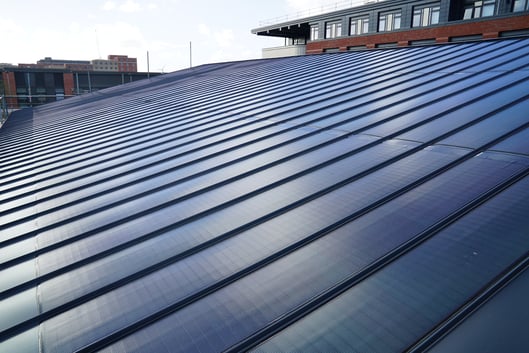
The Active Classroom and its integrated photovoltaic roof that generates solar energy which is then converted to heat and light for the building
Construction of Active Homes Neath is now under way, which will provide 16 new, eco-friendly homes. Crucially, the homes will add to Neath’s social housing stock, helping to cut down on the housing’s carbon footprint. (Currently, domestic buildings account for 27% of the UK’s carbon emissions.) Worsley is also keen to stress that the future residents of these homes ‘are not people that can necessarily afford both fuel and food. Because they will live in a house that pretty much powers itself, that difficult choice is hopefully not something that they're ever going to have to go through. I think that angle is really important.’
The opportunity for input to the Neath Homes project is the result of not just years of collaboration but also two bits of luck, says Worsley. The first instance was that Swansea University decided to help pay for and provide land to site the two prototype buildings. The second was a pot of money available due to a UK Government underspend – but to capitalise on this meant that the project had to come together quickly. ‘I remember filling out the order form for the building components on Christmas Eve,’ he says. The whole thing had to be finished by the end of the tax year – so about three months from start to finish. ‘It just shows you what you can do when you need to do it. And it has taught us an immense amount.’
He says that for the project, the demonstrator buildings are absolutely critical for several reasons. First and foremost, building the classroom was, he explains, ‘a really powerful bonding exercise for all of our teams who work in different areas of the energy space. You’ve got scientists like me thinking about electron trapping and chemistry and things. But you’ve also got electrical engineers and storage experts and construction engineers. We all worked together to design it, build it and put it together.
‘While it was probably a stretch too far in terms of being a commercially attractive proposition, it was incredibly important to demonstrate what was already possible. The next building, the Active Office, was then much more about using commercial material sets to show that it was something you could do in a replicable fashion.’
In its first phase of operation, Worsley admits, the Active Classroom didn’t quite perform as they had hoped. ‘It has taken us a while to optimise operating the building. But again, that has been really useful learning. And that’s why it’s important this kind of work is supported by the public sector – so you can test your idea and get it working properly before it’s out in the marketplace in a different way.’
Human-centric solutions
Well-known in the research community for his collaborative spirit and love for mentoring, it’s no surprise that Worsley found the way so many disciplines came together in the builds very rewarding. There was another benefit too, in terms of ensuring the buildings met a very important – but often overlooked – criteria.
‘We started off thinking about chemistry, materials and things like that, because that was our background. But our success has come from integrating all sorts of expertise including very important angles around the human interface, such as computational science and social science. People with technological aspirations quite often forget about the human element, which is the person that lives or works in, or has to deal with, a building.’
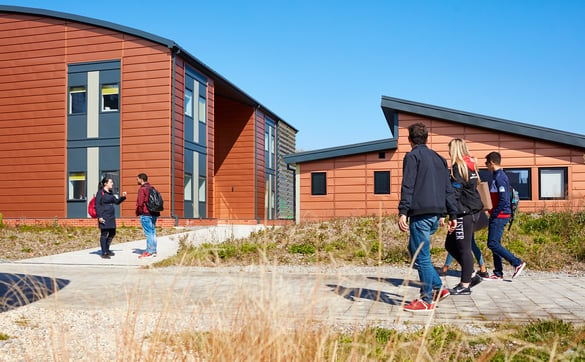
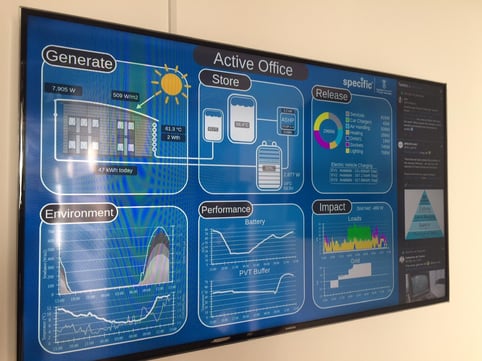
The Active Office and its energy usage display
He points to examples of modern buildings where something as simple as changing the room temperature might mean calling a management company, or where you can’t open a window because it’s controlled by a central computer. ‘Things like that really make people angry about the imposition of technology on their lives, especially when it comes to their individual homes.’
For Worsley, remembering that you need buy-in from people to make change possible is absolutely crucial. We’ve got a huge mountain to climb in terms of turning technology towards creating a net-zero carbon future. And when it comes to changing the way we build and live, it’s going to take a change of mindset to build momentum.
Of course, ‘you have to start from a basic principle of designing the thing really well in the first place, so that you don’t need to use as much energy. And then a critical factor in the success of technologies is not forgetting that they’re all operated by and lived in by humans. Making the technology pleasurable to use is almost as important as the technology itself.’
Ultimately, he continues: ‘You want people to embrace the new technology because it’s cool, it’s easy to use, it’s saving them money and saving the planet.’ And that doesn’t mean looking for one ‘magic bullet’ technology that’s going to solve all our problems (as we’re prone to doing). Instead, ‘you get that by layering up your technologies in an appropriate way’.
“You want people to embrace the new technology because it’s cool, it’s easy to use, it’s saving them money and saving the planet.”
In the Active Buildings, that means drawing on solar-powered electricity, solar thermal collectors and heat storage. And now there are new companies coming along, some of which have visited the SPECIFIC buildings and are building on what they’ve seen.
‘What’s really gratifying,’ says Worsley, is that these new entrants ‘have grown into the space and are just getting on with it – not only using the concepts we’ve talked about in terms of electrical or thermal generation and storage but using ground- or air-source heat pumps.
‘It’s brilliant to see these, and this sort of wave building, which is showing the large house builders, for example, what they could do.’
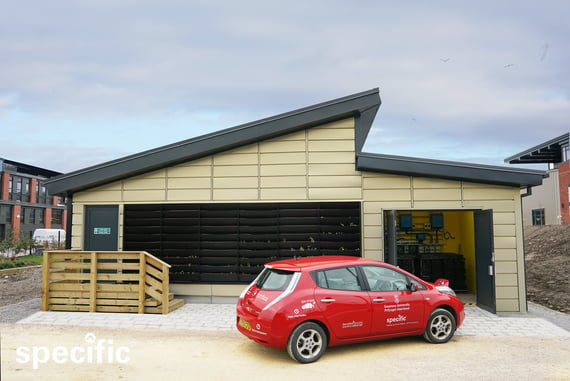
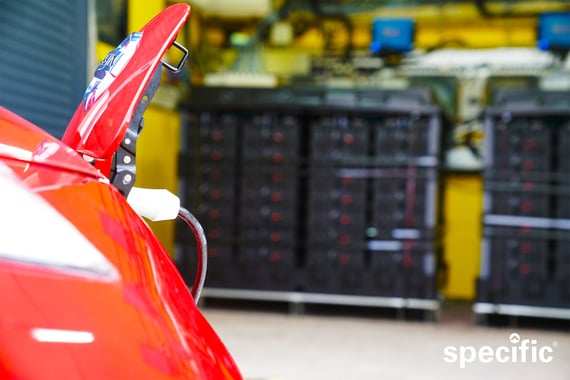
On sunny days, the Active Classroom generates enough excess energy to charge the SPECIFIC electric car
The Active Building Centre, created in the wake of the success of the SPECIFIC demonstrator buildings, has now begun to look at commercial-scale developments. SPECIFIC researchers are also working on printed photovoltaics that might solve the enormous challenge of retrofitting the UK’s traditional building stock to make it meet the government target of net-zero by 2050.
As Worsley points out, ‘80% of the buildings that are going to be here in 2050 are here already’, so sympathetic solutions are required. Worsley believes that it will eventually be possible to produce solar cells that can be hidden from view in a heritage setting, such that they look like a tile or zinc roof.
In addition, he notes that there has been a rush of innovation on the photovoltaic coating side since about 2012 ‘and some really great science in increasing both the efficiency and longevity of organic and perovskite solar cells – basically two versions of a very effective, easily coated solar cell.’ By using a printing and coating process, these cells can be integrated into a range of roofing and walling materials, potentially at great speed. These materials could then create active surfaces that generate power to run the buildings of the future and also provide extra power, for instance to charge electric cars.
In a unique pilot production plant, Worsley’s teams have access, he says, to ‘every kind of printing and coating process all under one roof’ and can ‘go from coating things that are 1mm2 all the way to roll-to-roll processing, so we can help people take their new material on a journey all the way through to a product’.
But those involved in the SPECIFIC project welcome the input coming from industry and the private sector, perhaps inspired by its projects: ‘That is our role as an institution really, to try and help and support the creation of a change process. It doesn’t have to be us doing all of it.
‘For me, the exciting thing is that there are all these technologies lining up which can be used [to meet the net-zero goal], and that there’s lots and lots of really inventive people around the world… It’s incredible what people are able to invent when there’s a demand.’
Generational benefits are exciting
Andrew Mears, a partner in the engineering team at Mewburn Ellis comments:
"For me, the thing that makes solar energy technologies so exciting is that they provide a real solution to the environmental crisis that affects all of us. It is easy to understand what benefits solar energy technologies can provide to each of us, in our homes, workplaces and in our wider communities. Constructing new buildings that are energy positive and updating existing buildings to be carbon neutral will provide environmental benefits that last for generations. Professor Wolsey’s comments make me very excited about our solar-powered future and all the innovations that it is inspiring."
Take an interactive tour of Active Homes Neath here or explore the Active Classroom and Office here.
Written by Caitlin Mackesy Davies.
Images provided by SPECIFIC
Andrew is a Partner and Patent Attorney at Mewburn Ellis. He deals with drafting and prosecuting patent applications at the EPO and UKIPO, as well as global patent portfolio management, Freedom-to-Operate (FTO) work and advising on global patent filing strategies. Andrew works in the engineering and electronics fields, with a focus on medical device technologies. He has spent time working as a patent attorney in Singapore, where he specialised in providing advice on obtaining patent protection throughout South-East Asia, China and the Indian sub-continent. Andrew has also worked in Canada, developing an expertise in obtaining patent protection in North America.
Email: andrew.mears@mewburn.com


